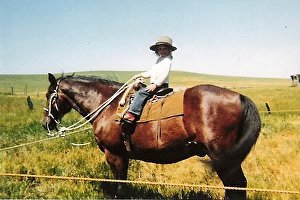Sheridan: A Community of Creative Exchange
 |
| I always remembered Concho as my first horse, but it turns out he was my second, lol. |
After wanting the book for years, I finally bought Saddlemakers of Sheridan Wyoming,
written by friend and long-time Sheridan County resident, the late Ann
Gorzalka. Having grown up with my
backside in the comfy curve of a succession of Rudy Mudra saddles, which had
sat generations of my family, I appreciate the history and artistry of the
Sheridan saddle makers. What
surprised me most about the book was reading how these artisans helped and
learned from each other- a web of influences and associations, intertwining
into the distinctive style of leather carving Sheridan's known for.
A quick skim through the pages reveals: (Read this really
FAST for effect!) Frank Morrow (who was, incidentally, Sheridan County Sheriff
from 1891-'94, and the maker of artist Hans Kleiber's chaps, currently on loan
at the Sheridan County Museum) sold his saddle shop to Otto F. Ernst, who had
worked for another saddle maker, George Parmeter. Rudy Mudra worked for Otto Ernst, then Reuben Bloomberg
before opening his own shop, where he taught Don King saddle making. John Ernst also taught King and many
others listed in the book. King
mentored sons, Bruce and John, and also Bill Gardner, who went on to become
a master saddle maker, putting his freehand carving on saddles for Ernst,
Bloomberg, Mudra & King. Mudra
retired and sold his saddle shop to young apprentice, Lloyd Davis. Davis mentored Chester Hape and Don
Butler. Hape also learned from
John Ernst and Don King before opening his own shop and mentoring his son
Wayne, and Steve Stevenson. Joe
Crackenburger worked for Ernst and mentored Fred Dooley. Don Butler mentored
Bob Douglas and Lonnie Gorzalka.
Nearly every Sheridan saddle maker in the book learned from
another through apprenticeship, partnership or friendship. It reminds me of Sheridan County
artists today: many share ideas and learn from each other while practicing
their skills together, creating a community of creative input and
exchange. [Thinking of the Impressionists, isn't this how artistic movements get started?]
With easy access to schooling today, it's easy to overlook
the opportunities to learn from people in our own community. Much of what I've learned since my
three semesters of junior college in the 80's hasn't come from a classroom, but
in listening to other artists. I
remember their opinions and the advice they offer, whether at an art opening, a
museum, an art presentation, exhibit or elsewhere.
For example, while looking at my art years ago, renowned artist Joel Ostlind
remarked, "Values are very important." Though I didn't really see it at the time, I knew it was
something to remember and work toward. Today I look back at my work from that
era and yes- the values were shallow. Often it's years before a suggestion makes sense to
me, but as my skills improve, those remembered tips become clearer. When I paint, I remember what was proffered,
and in my mind, these artists are there with me, helping me much like the early
saddle maker mentors. I could spend pages listing what I've learned from nearly
every artist I've ever spoken with. (another blog post!)
We know the names of those early saddle makers because they
were talented, learned from the best, diligently produced, and created a
following of clients and a network of support for each other and the next
generation of artisans. There are
many ways to find a network of support today. Sagebrush Art Center and Sheridan College offers classes
where beginners and professionals train and critique in a spirit of
camaraderie. Several local groups
draw or paint together, indoors or outdoors, year-round. Jentel Presents, a monthly event held at
the Sagebrush, gives you access to artists and ideas from around the country
and the world. Visit The Brinton Museum or
galleries with an artist friend and discuss the art on their walls. While presentations and receptions at
the Sagebrush are free and open-to-the-public, a $40 annual membership to SAGE
(Sheridan Artists' Guild, Et al) will keep you up-to-date on artsy
opportunities and entitle you to discounts on most workshops.
As it was with saddle makers of yesteryear, Sheridan County is brimming with artists and opportunities for casual learning from experienced professionals. Technology gives us a broader web of influences and associations, but seeing art in person and speaking with other artists cannot be matched. Taking part in this community of creative input and exchange can improve your skills, and you can in turn, help other artists do the same.
My solo show, "Cow Country," exhibits my informal education
by our community's artists. See it
at Sagebrush Art Center's Front Gallery, Tue - Fri, 10-5, through March 8th.




